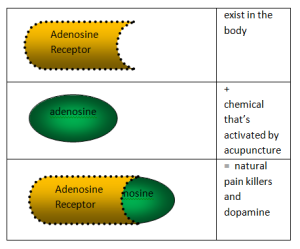Needle Pleasure
by Leena Prasad
| topic | acupuncture |
| region | all regions |
| chemicals | adenosine, dopamine |
Adele’s eyes are closed. The music in the background slowly unties the knots in her muscles. She feels the tiny prick of the needles as they are inserted into her forehead, the side of her head, and near her eyes. A few needles are inserted near her ears while she lies face up on a massage table. Adele cannot see all the acupuncture needles that stick out from her face and does not feel any pain after the sensation of the initial prick.
Acupuncture releases a neurotransmitter called adenosine. One of the many roles of adenosine is to help in pain control. When the human skin is punctured with small holes, the body responds by preparing itself to manage the pain via the release of adenosine. This release of this neurotransmitter also acts on other pain in the body. Essentially, acupuncture coaxes the body into releasing a natural painkiller.
The acupuncturist places little fragrant eye pillows over Adele’s closed eyes, tells her to relax, and to not move her head. “It is best not to fall asleep,” she advises. She puts a small bell in Adele’s right hand and tells her to ring the bell if she needs anything. Adele hears soft footsteps moving towards the door, the flip of the light switch, and the door closing. She does not feel the needles at all. Instead, she feels relaxed and pampered, as if she is at a health spa.
After several minutes, Adele feels changes in the intensity of her migraine. The headache is not gone, but it is starting to wane in intensity. This makes her wonder if this is due to her psychological expectations or if there are actual physiological responses in her body. She knows that acupuncture works for many people but not everyone.
Adenosine attaches to receptors in order to transmit its message for releasing pain killers. It is possible to have insufficient or malfunctioning adenosine receptors. Thus, people with problematic  receptors will not have the same level of benefit from a treatment as someone with healthy receptors.
receptors will not have the same level of benefit from a treatment as someone with healthy receptors.
After several minutes, Adele starts to feel drowsy, but concentrates on staying awake, and using her mental energy to focus on chasing away the migraine. Adenosine slows down nerve signals thus causing drowsiness and relaxation. Eventually, the acupuncturist comes back into the room and removes the needles from Adele’s head. Adele can feel the change already. The migraine is not completely gone but it is much less severe. She feels happy and has to resist an urge to hug the acupuncturist.
Adele is in a great mood for the rest of the evening because the adenosine in her body causes a chain reaction of activating the feel-good neurotransmitter dopamine. Convinced about the results of the treatment, she calls the acupuncturist and leaves a message to request recurring weekly appointments. Although her decision for regular treatment might be motivated by the mood enhancing effects of dopamine, several studies show that consistent use of acupuncture is useful in reducing the intensity and frequency of migraine headaches.
This is a monthly column published in SynchChaos.com magazine and Leena is looking for other syndication opportunities. Leena Prasad has a writing portfolio at FishRidingABike.com. Links to earlier stories in her monthly column can be found here.
Josh Buchanan, a UC Berkeley graduate, edits this column with an eye on grammar and scientific approach.
Dr. Nicola Wolfe is a neuroscience consultant for this column. She earned her Ph.D. in Clinical Psychopharmacology from Harvard University and has taught neuroscience courses for over 20 years at various universities.
References:
- Vickers, Andrew J., et all, Acupuncture for Chronic Pain, JAMA Internal Medicine, http://archinte.jamanetwork.com/article.aspx?articleid=1357513, Oct 2012
- Goldman, Nanna., et all, Adenosine A1 receptors mediate local anti-nociceptive effects of acupuncture, Nature Neurosicence, http://www.nature.com/neuro/journal/v13/n7/full/nn.2562.html, March 2010
- Fredholm, Bertil B.,PhD; Svenningsson, Per MD PhD, Adenosine–dopamine interactions, Neurology, December 9, 2003 vol. 61 no. 11 suppl 6 S5-S9
- Takano T., Chen X., et all, Traditional acupuncture triggers a local increase in adenosine in human subjects. 2012 Dec;13(12):1215-23. doi: 10.1016/j.jpain.2012.09.012.


Pingback: Synchronized Chaos » Blog Archive » May 2013: Journeys through Time, Space, and the Mind